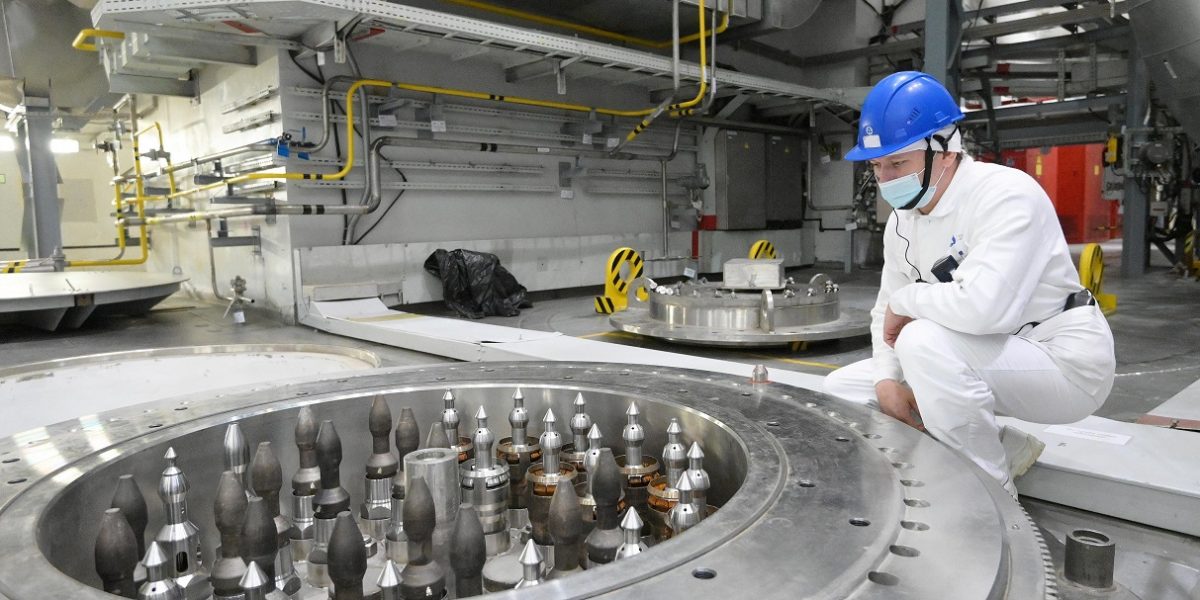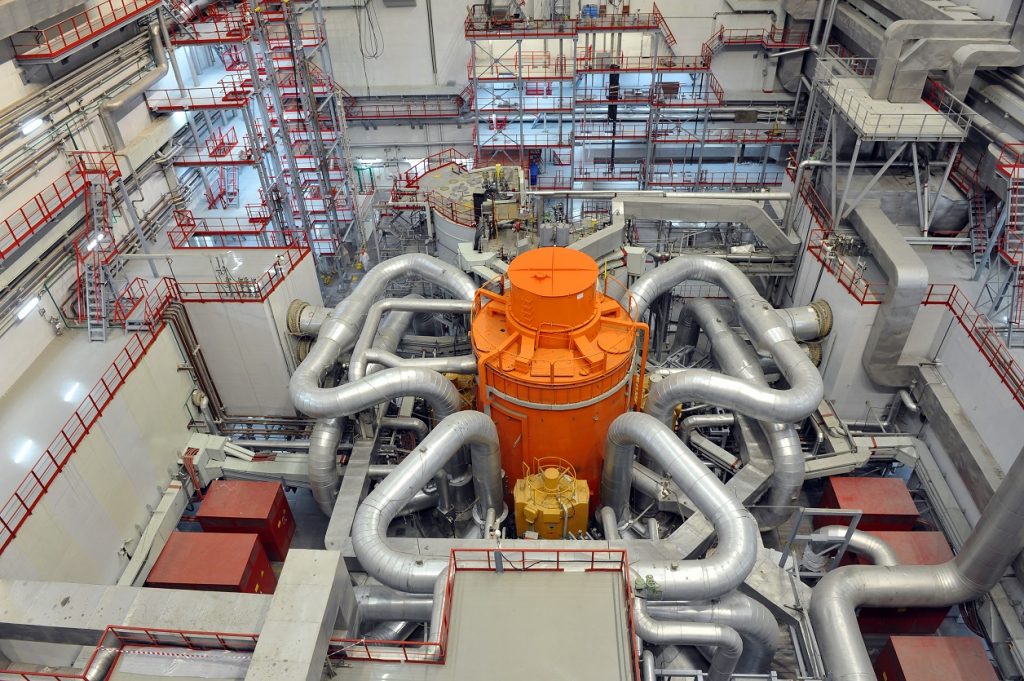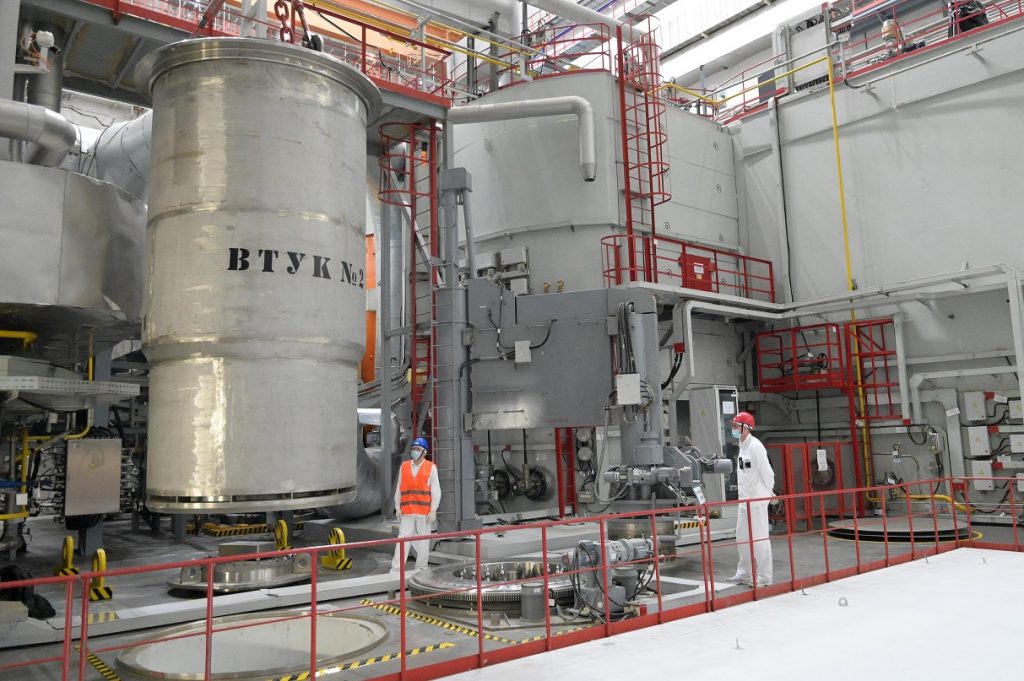
The BN-800 reactor at Unit 4 of the Beloyarsk NPP has completely switched over to MOX fuel. This is an important step in building a two-component nuclear power industry with the closure of the nuclear fuel cycle.
Source… https://strana-rosatom.ru/2022/09/09/reaktor-bn-800-polnostju-pereshel-na-moks/
Previously, conventional uranium fuel was loaded into Russian fast neutron reactors, as sodium technologies were tested on them. The BN-350 and BN-600 were used to study the behavior of fuel rods at high temperatures and an intense neutron flux. The study of fuel rods helped to improve them. For example, the average fuel burnup in BN-600 was almost doubled, from 40 to 74 MW day/kg. The result is also important for mixed oxide fuel: studies have shown that its behavior is similar to that of uranium.
The BN-800 was designed from the start for MOX fuel, but it was loaded gradually. In 2014, most of the launch load was conventional uranium oxide fuel, MOX fuel was 16%. It was made at the pilot plants of Mayak and RIAR. Serial fuel for BN-800 is made by the Mining and Chemical Combine. For pellets, depleted uranium and high-background plutonium extracted from irradiated fuel from thermal reactors are used.
In January 2021, after another refueling, the share of MOX fuel increased to a third. In January of this year, up to two-thirds. At the end of June, during a scheduled repair, the last third was loaded into the reactor, and at the beginning of September the unit was connected to the network.

Full load
In addition to assemblies with MOX fuel, rods are located in the core that perform auxiliary functions – this is a screen that prevents neutron leakage. Steel rods reflect fast neutrons and return them to the core, while depleted uranium rods absorb them. As a result, uranium-238 in depleted uranium, after a chain of decays, turns into plutonium-239, which can participate in a chain reaction. Due to the use of steel rods that do not contain uranium, the fuel’s breeding ratio (the ratio of fissile nuclei formed to the number of burnt out) of the fuel is less than 1, but there are no plans to replace steel with depleted uranium.
“The full load of MOX fuel shows that another big step has been taken towards a closed nuclear cycle. The use of MOX fuel will make it possible to increase the fuel base of the nuclear power industry tenfold. And most importantly, irradiated nuclear fuel from other NPPs can be reused in the BN-800 reactor after appropriate processing,” said Ivan Sidorov, director of the Beloyarsk NPP. “This is exactly the milestone for which the BN-800 was designed, a unique nuclear power unit and automated fuel production at the Mining and Chemical Combine were built,” stressed Alexander Ugryumov, Senior Vice President for Scientific and Technical Activities of TVEL.
There are disputes in the industry about which configuration of the Russian nuclear power industry is the safest and most economical: whether thermal reactors are needed if fast ones appear, or whether one fast reactor should be built for several thermal ones, which fast ones to build, and so on. But in any case, the experience of the Beloyarsk NPP will provide answers to some questions and bring closer the creation of a technological platform based on a closed nuclear fuel cycle.

World experience
In the 1970s, the French Phoenix reactor was the first to operate solely on MOX fuel. Due to four incidents – a sudden sharp drop in reactivity – it was stopped, then started, then stopped again and finally drowned out in February 2010. Now MOX fuel is used in French thermal neutron reactors, but its share does not exceed a third of the core. Irradiated fuel assemblies are not sent for reprocessing, this possibility is only being studied.
In China, the CEFR experimental fast reactor was launched in 2011, and a demonstration unit with CFR-600 is currently under construction, which should be launched in 2023. Russian fuel with enriched uranium is used to load Chinese reactors: in 2016, TVEL signed a contract for CEFR, in 2018 for CFR-600.
In Japan, fast reactors were not so lucky: in 1995, Monju experienced a major sodium leak four months after launch. Then 15 years of repair, restart and another accident. Since then, the reactor has not been operating, and there are no plans to build another one. MOX fuel in Japan is used in thermal reactors of four nuclear power plants, it is supplied from France.
In the United States, the construction of a MOX fuel production facility was abandoned in 2018 for a number of technological and organizational reasons. Most of the time and money went into designing the plant and making countless edits. The equipment that is still bought is being sold. In the UK, the plant was built in 1997, but it never reached its design capacity, and in 2011 it was decided to stop it.
QUESTION TO EXPERTS
Under what conditions can we say with certainty that a two-component power generation with CNFC has been built?
Vladimir Asmolov
Advisor to the General Director of Rosatom
— The first two conditions are 100% safety and economic efficiency: ideally, NPPs involved in the NFFC should be better than combined-cycle plants in terms of their parameters. The third condition is that fuel must become renewable. We now use less than 1% natural uranium for fuel. It is necessary to involve uranium-238, which makes up more than 99% of natural uranium, in the fuel cycle in order to obtain plutonium and reuse it in reactors. Then we can say that we have renewable fuel. The fourth condition is to prove to everyone that we are able to work with SNF and high-level waste. I hope we will solve this problem with the help of fast neutron reactors. On the whole, we have a lot of work to do in preparing thermal and fast reactors for joint operation in a closed fuel cycle. For thermal neutron reactors, it is necessary to increase the efficiency due to the transition to new thermodynamics. They should have a higher nuclear fuel reproduction ratio. Now it is somewhere around 0.4, and we want to increase it to 0.7-0.9. The most important task for fast neutron reactors is to make them economically comparable to thermal reactors. While the fast ones are more expensive. The fuel breeding factor in fast neutron reactors must be greater than unity. Then they will be able to be donors of fuel for VVER and, in general, the breeding coefficient for the system will be about one. so that they are comparable in economics with thermal reactors. While the fast ones are more expensive. The fuel breeding factor in fast neutron reactors must be greater than unity. Then they will be able to be donors of fuel for VVER and, in general, the breeding coefficient for the system will be about one. so that they are comparable in economics with thermal reactors. While the fast ones are more expensive. The fuel breeding factor in fast neutron reactors must be greater than unity. Then they will be able to be donors of fuel for VVER and, in general, the breeding coefficient for the system will be about one.
Boris Vasiliev
Advisor to the General Director of OKBM im. Afrikantov on the fuel cycle of fast reactors
– The main conditions are the serial construction of fast reactors and the creation of facilities for the processing of spent nuclear fuel, including spent fuel from fast reactors, as well as enterprises for the manufacture of mixed uranium-plutonium fuel.
Vadim Lemekhov
Chief Designer of the Proryv project and BREST-OD-300 reactor plant, NIKIET
— We can confidently talk about two-component nuclear power with CNFC when VVER spent nuclear fuel with a short holding time is used to start new fast reactors, and fast reactors will be work on your own regenerator. This is a sign of technology stability.